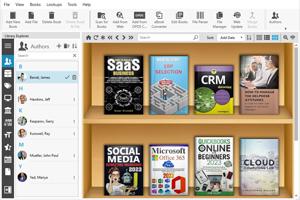5 books on Cloud Computing [PDF]
Updated: January 08, 2024 | 18 |
Books on Cloud Computing serve as invaluable resources for startups venturing into the dynamic realm of cloud services, including Platform as a Service (PaaS) and Infrastructure as a Service (IaaS). These references provide a comprehensive foundation, covering various aspects of cloud computing, from cloud architecture and deployment models to security and scalability considerations. They delve into advanced techniques for building robust, scalable, and secure cloud solutions that cater to the diverse needs of businesses. These books often include practical examples, case studies, and insights into the latest cloud technologies, enabling startups to navigate the complexities of the cloud industry.
1. Cloud Computing: Theory and Practice
2017 by Dan C. Marinescu

"Cloud Computing: Theory and Practice, Second Edition," offers a comprehensive exploration of the cloud computing landscape for both students and IT professionals. Starting with an introduction to network-centric computing and content, the book is organized into four sections. The first covers fundamental concepts of concurrency, parallelism, and distributed systems. The second section delves into critical components of the cloud ecosystem, including service providers, access, data storage, and hardware/software. Cloud applications and security are discussed in the third section, while the fourth section explores research topics in cloud computing. New chapters address concurrency, cloud hardware/software, challenges posed by big data and mobile applications, and advanced topics such as the impact of scale on efficiency. With over 400 references, including recent research results, and a glossary covering various categories, this edition provides a comprehensive understanding of cloud computing from the ground up.
Download PDF
2. Encyclopedia of Cloud Computing
2016 by San Murugesan, Irena Bojanova

The Encyclopedia of Cloud Computing serves as a comprehensive resource for IT professionals, educators, researchers, and students, offering a compendium of knowledge on various aspects of cloud computing. Crafted by a diverse group of subject matter experts from both industry and academia, this singular volume delves into an array of cloud computing subjects, encompassing technological trends, research opportunities, best practices, standards, and adoption strategies. It provides a multi-faceted view, addressing queries that stakeholders may have regarding the development, operation, management, and utilization of cloud services. The encyclopedia, organized into 10 sections with 56 chapters, covers a spectrum of topics, each with cross-references, tables, illustrations, and side-bars as applicable. With summaries at the beginning and additional resources at the end of each chapter, it serves as a valuable guide to understanding the present and future impact of cloud computing.
Download PDF
3. Cloud Computing: SaaS, PaaS, IaaS, Virtualization, Business Models, Mobile, Security and More
2013 by Kris Jamsa

Cloud computing is revolutionizing the interaction between businesses and users with computers and mobile devices. The era of costly data centers, extensive IT support teams, and racks of disk drives is being replaced by on-demand software applications delivered from the cloud. This comprehensive guide, "Cloud Computing," unveils the hands-on aspects of the cloud, guiding readers through the utilization of cloud-based data storage, sharing digital media, performing automated backups, and engaging with various applications by the end of the first chapter. The book delves into software as a service (SaaS), platform as a service (PaaS), infrastructure as a service (IaaS), server and desktop virtualization, and more. Each chapter explores a specific cloud topic, examines its underlying business case, and provides real-world case studies. Whether readers are looking to migrate to the cloud, gain insights into cloud fundamentals, develop future cloud solutions, or understand recent cloud advancements, this book is an invaluable resource.
Download PDF
4. Cloud Computing: Principles, Systems and Applications
2010 by Nikos Antonopoulos, Lee Gillam

Cloud computing has recently become a significant focus in both industry and academia, sparking intense debates about its meaning and scope. While some researchers view clouds as a natural progression toward fully commercialized grid systems, others dismiss the term as a mere rebranding of existing pay-per-use technologies. Regardless, "cloud" has become the preferred label for accountable pay-per-use access to third-party applications and extensive computational resources. Clouds facilitate patterns of unpredictable resource usage across a spectrum of IT applications, from online office tools to high-throughput transactional services and resource-intensive computations. This book offers a comprehensive exploration of the current state of cloud computing, elucidating the conceptual and systemic connections with other distributed computing approaches, such as grid services, web services, and data centers.
Download PDF
5. Cloud Computing: Principles and Paradigms
2010 by Rajkumar Buyya, James Broberg, Andrzej M. Goscinski

The primary goal of this book is to encapsulate the cutting-edge developments in Cloud Computing technologies and applications, aiming to pinpoint potential research avenues and technologies that can establish a global marketplace for cloud computing services supporting diverse applications. Serving as a valuable reference, the book targets a broad audience, including systems architects, practitioners, developers, new researchers, and graduate-level students. Given the recent emergence of this research area, there is a notable lack of comprehensive reference books, making this contribution both timely and essential. Tailored for professional computer science developers and graduate students, particularly at the Masters level, the book addresses a field with growing research interest and commercial significance. Recognized as one of the top five emerging technologies set to impact science and society significantly, the knowledge shared in this book positions readers at the forefront of Cloud Computing.
Download PDF
How to download PDF:
1. Install Google Books Downloader
2. Enter Book ID to the search box and press Enter
3. Click "Download Book" icon and select PDF*
* - note that for yellow books only preview pages are downloaded
1. Cloud Computing: Theory and Practice
2017 by Dan C. Marinescu

"Cloud Computing: Theory and Practice, Second Edition," offers a comprehensive exploration of the cloud computing landscape for both students and IT professionals. Starting with an introduction to network-centric computing and content, the book is organized into four sections. The first covers fundamental concepts of concurrency, parallelism, and distributed systems. The second section delves into critical components of the cloud ecosystem, including service providers, access, data storage, and hardware/software. Cloud applications and security are discussed in the third section, while the fourth section explores research topics in cloud computing. New chapters address concurrency, cloud hardware/software, challenges posed by big data and mobile applications, and advanced topics such as the impact of scale on efficiency. With over 400 references, including recent research results, and a glossary covering various categories, this edition provides a comprehensive understanding of cloud computing from the ground up.
Download PDF
2. Encyclopedia of Cloud Computing
2016 by San Murugesan, Irena Bojanova

The Encyclopedia of Cloud Computing serves as a comprehensive resource for IT professionals, educators, researchers, and students, offering a compendium of knowledge on various aspects of cloud computing. Crafted by a diverse group of subject matter experts from both industry and academia, this singular volume delves into an array of cloud computing subjects, encompassing technological trends, research opportunities, best practices, standards, and adoption strategies. It provides a multi-faceted view, addressing queries that stakeholders may have regarding the development, operation, management, and utilization of cloud services. The encyclopedia, organized into 10 sections with 56 chapters, covers a spectrum of topics, each with cross-references, tables, illustrations, and side-bars as applicable. With summaries at the beginning and additional resources at the end of each chapter, it serves as a valuable guide to understanding the present and future impact of cloud computing.
Download PDF
3. Cloud Computing: SaaS, PaaS, IaaS, Virtualization, Business Models, Mobile, Security and More
2013 by Kris Jamsa

Cloud computing is revolutionizing the interaction between businesses and users with computers and mobile devices. The era of costly data centers, extensive IT support teams, and racks of disk drives is being replaced by on-demand software applications delivered from the cloud. This comprehensive guide, "Cloud Computing," unveils the hands-on aspects of the cloud, guiding readers through the utilization of cloud-based data storage, sharing digital media, performing automated backups, and engaging with various applications by the end of the first chapter. The book delves into software as a service (SaaS), platform as a service (PaaS), infrastructure as a service (IaaS), server and desktop virtualization, and more. Each chapter explores a specific cloud topic, examines its underlying business case, and provides real-world case studies. Whether readers are looking to migrate to the cloud, gain insights into cloud fundamentals, develop future cloud solutions, or understand recent cloud advancements, this book is an invaluable resource.
Download PDF
4. Cloud Computing: Principles, Systems and Applications
2010 by Nikos Antonopoulos, Lee Gillam

Cloud computing has recently become a significant focus in both industry and academia, sparking intense debates about its meaning and scope. While some researchers view clouds as a natural progression toward fully commercialized grid systems, others dismiss the term as a mere rebranding of existing pay-per-use technologies. Regardless, "cloud" has become the preferred label for accountable pay-per-use access to third-party applications and extensive computational resources. Clouds facilitate patterns of unpredictable resource usage across a spectrum of IT applications, from online office tools to high-throughput transactional services and resource-intensive computations. This book offers a comprehensive exploration of the current state of cloud computing, elucidating the conceptual and systemic connections with other distributed computing approaches, such as grid services, web services, and data centers.
Download PDF
5. Cloud Computing: Principles and Paradigms
2010 by Rajkumar Buyya, James Broberg, Andrzej M. Goscinski

The primary goal of this book is to encapsulate the cutting-edge developments in Cloud Computing technologies and applications, aiming to pinpoint potential research avenues and technologies that can establish a global marketplace for cloud computing services supporting diverse applications. Serving as a valuable reference, the book targets a broad audience, including systems architects, practitioners, developers, new researchers, and graduate-level students. Given the recent emergence of this research area, there is a notable lack of comprehensive reference books, making this contribution both timely and essential. Tailored for professional computer science developers and graduate students, particularly at the Masters level, the book addresses a field with growing research interest and commercial significance. Recognized as one of the top five emerging technologies set to impact science and society significantly, the knowledge shared in this book positions readers at the forefront of Cloud Computing.
Download PDF
How to download PDF:
1. Install Google Books Downloader
2. Enter Book ID to the search box and press Enter
3. Click "Download Book" icon and select PDF*
* - note that for yellow books only preview pages are downloaded


